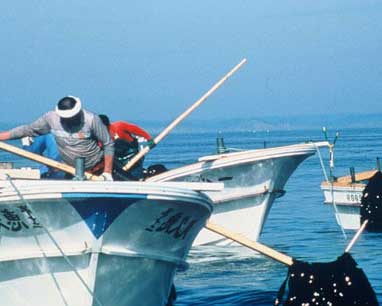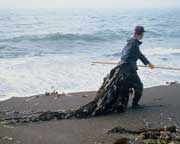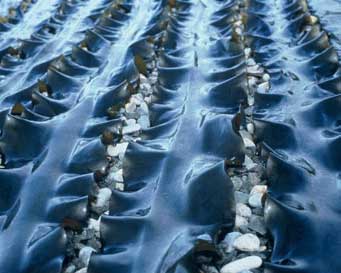



Kombu grows in shallow seas at depths of five to seven metres, absorbing the rays of the sun for sustenance. Over the course of two years, the kombu fronds wither once, then regrow even larger, thicker, and more delicious than before. In the late summer period of this second year of growth, the kombu is finally ready for harvest.
Traditionally produced kombu is dried outside in the open air after being harvested. For this reason, the weather is of great importance. Drawing on many years of experience, the kombu fishermen must carefully observe variations in climate and tidal flow to carry out their work. During the harvest period, which lasts from July till September, the fishermen gather each day at the break of dawn, awaiting the signal to set sail. The leader of the fishermen looks to the skies, and when he judges that the time is right, signals the others with his siren.
With clear blue skies overhead, men and women set out in small boats to gather in the harvest. First, the kombu is cut loose using sharp V-shaped hooks. Being careful not to damage their precious cargo, the fishermen aim for as close to the root as they can, then twist to set the kombu loose. The kombu floats up to the water surface and is gathered using short hooks attached to rods. The fishermen continue this tiring and difficult work until the afternoon, their boats piling high with kombu.
Once harvesting is finished, the kombu is quickly brought back to shore, washed individually by hand, then laid out across the pebbles in single layers to dry slowly in the sun. At night, the kombu must be stored indoors, then taken back outside to dry the following day. This process is repeated until the kombu has dried evenly.
Sun dying is vital to draw out the umami of the kombu. After being dried, the surface will be coated with white crystalized glutamic salts created by the interaction of glutamine amino acids with sea salt. If the kombu is washed under running water, these flavorsome minerals may be lost. Instead, the surface of the kombu should be wiped lightly with a well-wrung damp cloth to remove any dirt before use.


